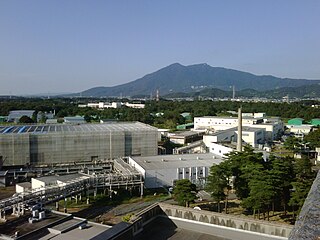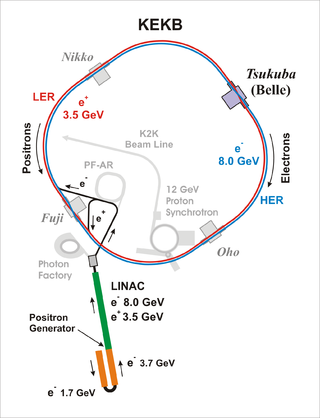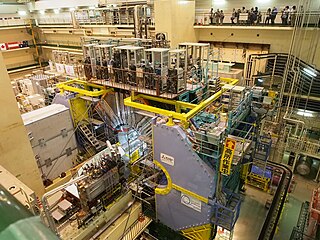Related Research Articles

Particle physics or high-energy physics is the study of fundamental particles and forces that constitute matter and radiation. The field also studies combinations of elementary particles up to the scale of protons and neutrons, while the study of combination of protons and neutrons is called nuclear physics.

DESY, short for Deutsches Elektronen-Synchrotron, is a national research centre for fundamental science located in Hamburg and Zeuthen near Berlin in Germany. It operates particle accelerators used to investigate the structure, dynamics and function of matter, and conducts a broad spectrum of interdisciplinary scientific research in four main areas: particle and high energy physics; photon science; astroparticle physics; and the development, construction and operation of particle accelerators. Its name refers to its first project, an electron synchrotron. DESY is publicly financed by the Federal Republic of Germany and the Federal States of Hamburg and Brandenburg and is a member of the Helmholtz Association.

The Tevatron was a circular particle accelerator in the United States, at the Fermi National Accelerator Laboratory, east of Batavia, Illinois, and is the second highest energy particle collider ever built, after the Large Hadron Collider (LHC) of the European Organization for Nuclear Research (CERN) near Geneva, Switzerland. The Tevatron was a synchrotron that accelerated protons and antiprotons in a 6.28 km (3.90 mi) ring to energies of up to 1 TeV, hence its name. The Tevatron was completed in 1983 at a cost of $120 million and significant upgrade investments were made during its active years of 1983–2011.
The bottom quark,beauty quark, or b quark, is an elementary particle of the third generation. It is a heavy quark with a charge of −1/3 e.

The Large Hadron Collider (LHC) is the world's largest and highest-energy particle collider. It was built by the European Organization for Nuclear Research (CERN) between 1998 and 2008 in collaboration with over 10,000 scientists and hundreds of universities and laboratories across more than 100 countries. It lies in a tunnel 27 kilometres (17 mi) in circumference and as deep as 175 metres (574 ft) beneath the France–Switzerland border near Geneva.
The BaBar experiment, or simply BaBar, is an international collaboration of more than 500 physicists and engineers studying the subatomic world at energies of approximately ten times the rest mass of a proton (~10 GeV). Its design was motivated by the investigation of charge-parity violation. BaBar is located at the SLAC National Accelerator Laboratory, which is operated by Stanford University for the Department of Energy in California.

In particle physics, a tetraquark is an exotic meson composed of four valence quarks. A tetraquark state has long been suspected to be allowed by quantum chromodynamics, the modern theory of strong interactions. A tetraquark state is an example of an exotic hadron which lies outside the conventional quark model classification. A number of different types of tetraquark have been observed.

The High Energy Accelerator Research Organization, known as KEK, is a Japanese organization whose purpose is to operate the largest particle physics laboratory in Japan, situated in Tsukuba, Ibaraki prefecture. It was established in 1997. The term "KEK" is also used to refer to the laboratory itself, which employs approximately 695 employees. KEK's main function is to provide the particle accelerators and other infrastructure needed for high-energy physics, material science, structural biology, radiation science, computing science, nuclear transmutation and so on. Numerous experiments have been constructed at KEK by the internal and international collaborations that have made use of them. Makoto Kobayashi, emeritus professor at KEK, is known globally for his work on CP-violation, and was awarded the 2008 Nobel Prize in Physics.

HERA was a particle accelerator at DESY in Hamburg. It was operated from 1992 to 30 June 2007. At HERA, electrons or positrons were brought to collision with protons at a center-of-mass energy of 320 GeV. HERA was used mainly to study the structure of protons and the properties of quarks, laying the foundation for much of the science done at the Large Hadron Collider (LHC) at the CERN particle physics laboratory today. HERA is the only lepton–proton collider in the world to date and was on the energy frontier in certain regions of the kinematic range.

The LHCb experiment is a particle physics detector experiment collecting data at the Large Hadron Collider at CERN. LHCb is a specialized b-physics experiment, designed primarily to measure the parameters of CP violation in the interactions of b-hadrons. Such studies can help to explain the matter-antimatter asymmetry of the Universe. The detector is also able to perform measurements of production cross sections, exotic hadron spectroscopy, charm physics and electroweak physics in the forward region. The LHCb collaboration, who built, operate and analyse data from the experiment, is composed of approximately 1650 people from 98 scientific institutes, representing 22 countries. Vincenzo Vagnoni succeeded on July 1, 2023 as spokesperson for the collaboration from Chris Parkes. The experiment is located at point 8 on the LHC tunnel close to Ferney-Voltaire, France just over the border from Geneva. The (small) MoEDAL experiment shares the same cavern.

KEKB was a particle accelerator used in the Belle experiment to study CP violation. KEKB was located at the KEK in Tsukuba, Ibaraki Prefecture, Japan. It has been superseded by its upgrade, the SuperKEKB accelerator. The SuperKEKB is a luminosity upgrade of KEKB. SuperKEKB had its first particle collisions in 2018. The SuperKEKB accelerator produces particle beams for the Belle II experiment, which is an upgrade of the Belle experiment. The Belle experiments studied b-quark hadrons to research CP violation.

The Belle experiment was a particle physics experiment conducted by the Belle Collaboration, an international collaboration of more than 400 physicists and engineers, at the High Energy Accelerator Research Organisation (KEK) in Tsukuba, Ibaraki Prefecture, Japan. The experiment ran from 1999 to 2010.
The High Luminosity Large Hadron Collider is an upgrade to the Large Hadron Collider, operated by the European Organization for Nuclear Research (CERN), located at the French-Swiss border near Geneva. From 2011 to 2020, the project was led by Lucio Rossi. In 2020, the lead role was taken up by Oliver Brüning.

Neutral B meson oscillations are one of the manifestations of the neutral particle oscillation, a fundamental prediction of the Standard Model of particle physics. It is the phenomenon of B mesons changing between their matter and antimatter forms before their decay. The
B
s meson can exist as either a bound state of a strange antiquark and a bottom quark, or a strange quark and bottom antiquark. The oscillations in the neutral B sector are analogous to the phenomena that produce long and short-lived neutral kaons.
The
B
s meson is a meson composed of a bottom antiquark and a strange quark. Its antiparticle is the
B
s meson, composed of a bottom quark and a strange antiquark.
In scattering theory and accelerator physics, luminosity (L) is the ratio of the number of events detected (dN) in a certain period of time (dt) to the cross-section (σ):

The Belle II experiment is a particle physics experiment designed to study the properties of B mesons and other particles. Belle II is the successor to the Belle experiment, and commissioned at the SuperKEKB accelerator complex at KEK in Tsukuba, Ibaraki prefecture, Japan. The Belle II detector was "rolled in" in April 2017. Belle II started taking data in early 2018. Over its running period, Belle II is expected to collect around 50 times more data than its predecessor, mostly due to a 40-fold increase in an instantaneous luminosity provided by SuperKEKB as compared to the previous KEKB accelerator.
SuperKEKB is a particle collider located at KEK (High Energy Accelerator Research Organisation) in Tsukuba, Ibaraki Prefecture, Japan. SuperKEKB collides electrons with positrons at the centre-of-momentum energy close to the mass of the Υ(4S) resonance making it a second-generation B-factory for the Belle II experiment. The accelerator is an upgrade to the KEKB accelerator, providing approximately 40 times higher luminosity, due mostly to superconducting quadrupole focusing magnets. The accelerator achieved "first turns" (first circulation of electron and positron beams) in February 2016. First collisions occurred on 26 April 2018. At 20:34 on 15 June 2020, SuperKEKB achieved the world’s highest instantaneous luminosity for a colliding-beam accelerator, setting a record of 2.22×1034 cm−2s−1.

Bradley Cox is an American physicist, academic and researcher. He is a Professor of Physics and the founder of the High Energy Physics Group at the University of Virginia.

Sheldon Leslie Stone was a distinguished professor of physics at Syracuse University. He is best known for his work in experimental elementary particle physics, the Large Hadron Collider beauty experiment (LHCb), and B decays. He made significant contributions in the areas of data analysis, LHCb detector design and construction, and phenomenology.
References
- ↑ Volk, J. T.; Yager, P. M.; Edelstein, R.; /Carnegie Mellon U.; Christian, D.; /Fermilab; Lundberg, B.; Reay, N. W.; Reibel, K.; Sidwell, R. A.; Stanton, N. (1987-01-01). Letter of Intent for a Tevatron Collider Beauty Factory (PDF) (Report). pp. FERMILAB–PROPOSAL–0783, 992264. doi: 10.2172/992264 .
- ↑ Križan, Peter (1999), "The HERA-B Experiment", in Lellouch, Daniel; Mikenberg, Giora; Rabinovici, Eliezer (eds.), International Europhysics Conference on High Energy Physics, Springer Berlin Heidelberg, pp. 1188–1191, doi:10.1007/978-3-642-59982-8_229, ISBN 978-3-642-64208-1
- ↑ Bevan, A. J.; Golob, B.; Mannel, Th.; Prell, S.; Yabsley, B. D.; Aihara, H.; Anulli, F.; Arnaud, N.; Aushev, T.; Beneke, M.; Beringer, J. (2014). "The Physics of the B Factories". The European Physical Journal C. 74 (11): 3026. arXiv: 1406.6311 . Bibcode:2014EPJC...74.3026B. doi:10.1140/epjc/s10052-014-3026-9. ISSN 1434-6044. S2CID 9063079.
- ↑ Aushev, T.; Bartel, W.; Bondar, A.; Brodzicka, J.; Browder, T. E.; Chang, P.; Chao, Y.; Chen, K. F.; Dalseno, J.; Drutskoy, A.; Enari, Y. (2010-02-26). "Physics at Super B Factory". arXiv: 1002.5012 [hep-ex].
- ↑ "Italy cancels €1bn SuperB collider". Physics World. 2012-11-28. Retrieved 2020-03-23.
- ↑ "SuperKEKB achieves its first collisions". Physics World. 2018-04-30. Retrieved 2020-03-16.
- ↑ "Experiments | CERN". home.cern. Retrieved 2020-03-23.